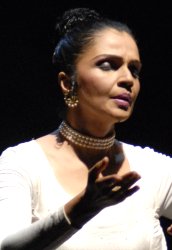 |
  |
 |
  |
| Past
Forward
- Anita R Ratnam, Chennai July 30, 2010 |
 I have been engaged in a growing debate on two topics on Face Book. One directly connects with dancers across the globe and the other with women. Are women poorer off when a marriage breaks up? That was the question asked by a national daily last week which spilled onto Facebook. When interviewed by the paper, I said that, in most cases, the woman is left with the children and the responsibility of caring for them and herself. She is forced to pursue legal means for alimony and child support and is often the bruised party. Especially in India, where custody issues and child support issues are tilted towards the man. Surprisingly, many women have disagreed with me, chiding women for weeping, whining and playing the "poor me" game. One actually said that "Men are not allowed to cry and thus suffer more!" Huh? Well, who made that rule if not for men themselves? Now why should this issue affect dancers? As creative women (and men - yes), the tussle between the artistic life and domestic ties is a constant losing battle. Too many marriages and relationships have cracked wide open because "the Dance would not leave the dancer alone." Insecure or jealous spouses, in-laws with double standards and the larger society unwilling to yield a professional space for dancers have made many marriages and relationships break apart. How many dancers do we know who have stepped out alone, penniless and homeless? How many men do we know who are in the same situation? On the dance front, many contemporary and classical dancers are arguing about creativity and the nature of contemporary dance in India. With the growing number of classically trained dancers "experimenting" and "innovating," it is becoming a blurred and highly contested area. For the past five years, many young dancers, between the ages of 25 to 35, have invested in new modes of physical training, taking time off from their known methods of working and performing and losing their audiences in the process. Today in India we have at least 25 to 30 young dancers and dance companies who are excellent contemporary dance practitioners, who do NOT apply classical dance kinetics or aesthetics to their methods. It is to these emerging artistes and the fast developing contemporary dance scene that I have hopes for. While there may be a shift of OPTIC in watching their work and sometimes even discomfort, it is this group that has furiously engaged with the wider arts scene and with society as a whole. Ask any visual and stage artiste about dance and they immediately feel closer to contemporary dance and dance theatre than the formalism of classical dance. Only a handful of classical dancers like Malavika Sarukkai, Geeta Chandran, Alarmel Valli, Aditi Mangaldas, Rama Vaidyanathan and Ananda Shankar have been able to reach out to both constituencies with varying degrees of success. Today, China and Russia are in the throes of Bollywood mania. There are official government dance delegations to both countries with heavy Filmi accents. Solo dancing is on the wane for cultural export and large ensembles are the norm. With hobbyists and part time dancers outnumbering serious professional artistes, the situation does not bode well for Indian dance. As I write this, we still do not have a national network of professional dance presenters. We neither have full time choreographers (except for Bollywood items) or dance mentors and dramaturgs. Our dance spaces are under equipped and dance is offered FREE. At the same time, theatre in India is thriving with tickets being the norm. Theatre artistes complain that dancers have more opportunities but the time has come to change their tune. For the forthcoming FESTIVAL OF INDIA in the USA, theatre opens the festival with three contemporary dance companies and three theatre companies occupying pride of place. Classical dance is a small component of the entire 3 week festival scheduled for March 2011. Also, two North American dance companies. Ragamala and Dakshina are part of the festival, heralding a coming of age for Indian dance in North America. So while the contemporary-classical-devadasi-pure-authentic debate may rage on in India and elsewhere, I say what critic Sadanand Menon said 15 years ago. The intellectual centre of Indian dance has shifted outside India and the technical standard of Bharatanatyam in Madras has fallen far below those in Bangalore, US and UK. Please add your comments as you please to this posting. Responses |